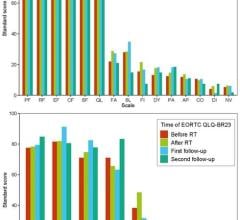April 29, 2016 — Elekta announced that its high-field MR-guided linear accelerator (MR-linac) platform will be the focal point of seven scientific presentations at ESTRO 35, the annual meeting of the European Society for Radiotherapy and Oncology. The meeting will take place April 29 – May 3, 2016, in Turin, Italy.
Elekta’s MR-linac integrates a state-of-the-art radiotherapy system and a high-field magnetic resonance imaging (MRI) scanner with sophisticated software that allows a physician to clearly see the patient’s anatomy in real time. The MR-linac is designed to improve targeting of tumor tissue while reducing exposure of normal tissue to radiation beams. It will allow physicians to precisely locate a tumor, as well as lock onto it during delivery, even when tumor tissue is moving during treatment or changes shape, location or size between treatment sessions.
At ESTRO 35, the potential of Elekta’s MR-linac will be discussed in the following sessions:
- Abstract SP-0485: “MR-linac: Clinical Introduction”; Christopher Schultz, M.D., FACR, professor in the Department of Radiation Oncology at Froedert and Medical College of Wisconsin. May 2, 2:30 p.m. - 4 p.m. This presentation will discuss the integration of MR-linac into current radiation therapy (RT) practice, the structure of the Elekta MR-linac Consortium and its plans to provide a robust body of evidence to support optimal development of MR-linac technology; and
- Abstract OC-0549: “The effects of magnetic field and real-time tumor tracking on lung stereotactic body radiotherapy”; Martin J. Menten, a doctoral candidate at The Institute for Cancer Research, London. May 2, 4:45 p.m. – 5:45 p.m. This study demonstrates that use of Elekta’s Monaco treatment planning software accounts for the effects of magnetic field during treatment planning and enables the design of clinically acceptable lung stereotactic body RT with a MR-linac. The data also show that the magnetic field does not compromise the ability of real-time tumor tracking to decrease dose exposure to healthy tissue.
“To evaluate the effect of the magnetic field and real-time tumor tracking, we modeled several dose-volume metrics and the amount of energy that would be delivered to patients with lung tumors,” explained Prof. Uwe Oelfke, MCCPM, FInstP, and head of the Joint Department of Physics at The Institute of Cancer Research, London, and The Royal Marsden NHS Foundation Trust. “Real-time tumor tracking would allow us to maintain dose coverage of gross tumor volume while reducing the dose delivered, which decreased exposure to skin and healthy lung tissue. This was observed with and without the presence of the magnetic field, demonstrating that Monaco effectively addresses the challenge posed by the interaction of the MRI with the delivery of radiation therapy.”
Additional presentations include:
- Abstract: OC-0075: “Impact of air around an ion chamber: solid water phantoms not suitable for dosimetry on an MR-linac”; S. Hackett, B. van Asselen, J. Wolthaus, J. Kok, S. Woodings, J. Lagendijk, B. Raaymakers; April 30, 10:45 – 11:45 a.m.;
- Abstract: OC-0076: “Towards MR-Linac Dosimetry: B-Field Effects on Ion Chamber Measurements in a Co-60 beam”; J. Agnew, G. Budgell, S. Duane, F. O'Grady, R. Young; April 30, 10:45 – 11:45 a.m.;
- Abstract: SP-0421: “Brachytherapy pelvic and MRI-Linac combination”; C.N. Nomden, A.A.C. de Leeuw, B.W. Raaymakers, J.J.W. Lagendijk, I.M. Jürgenliemk-Schulz; May 2, 8:45 – 10 a.m.;
- Abstract: SP-0483: “MRI Linac: physics perspective”; B. Raaymakers, J.J.W. Lagendijk; May 2, 2:30 – 4 p.m.; and
- Abstract: OC-0547: “Towards Portal Dosimetry for the MR-linac: back-projection algorithm in the presence of MRI scanner”; I. Torres Xirau, R. Rozendaal, I. Olaciregui-Ruiz, P. Gonzalez, U. van der Heide, J.J. Sonke, A. Mans; May 2, 4:45 – 5:45 p.m.
Elekta’s MR-linac is a work in progress and not available for sale or distribution.
For more information: www.elekta.com


 March 28, 2024
March 28, 2024 








